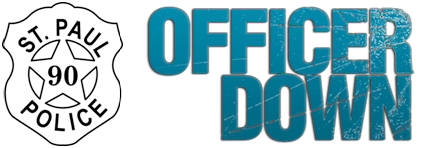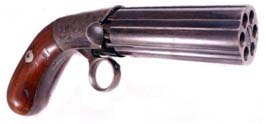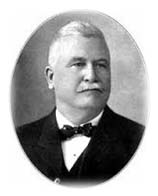The Saint Paul Police Crime Lab:
An Evolution In Forensics
by
Edward J. "Ed" Steenberg
Saint Paul Police Historical Society
Part II: The Detective Bureau

SPPD Circa 1864
On Tuesday, April 12,1864 a letter was read into the Common Council Record by the recently defeated Mayor John E. Warren, who wanted to create a Saint Paul Police Detective Bureau (aka Secret Service Department) prior to leaving office. The mayor stated in said valedictory address:
"In addition to the regular police, one or two experienced 'Detectives' should be constantly employed. This would add greatly to the efficiency of this department. The office of the ordinary police is to prevent crime -- of a detective to follow out secret clues and bring to light the perpetrators. It will not do, to withdraw men from their regular beats and set them to trace out the intricacies of an ingenious robbery which may take days and perhaps weeks to unravel. While the men are thus employed, other robberies might and probably would take place in the neighborhoods of their described beats. It would be well known that the men were away and their post unguarded. And thus, crime so far from being diminished, would be increased."
To facilitate the creation of a Detective Bureau, $200.00 6 was appropriated by the common council two weeks later (April 26, 1864). Under the direction of Chief Michael Cummings 7 the new unit was established just prior to his own removal from office 8. Also recommended was the establishment of sentry boxes in every ward "… as places of refuge for police on cold and stormy nights. This would obviate the apparent excuse they now have for resorting to saloons."
Please note that until police uniforms were mandated in 1872 everyone was "en muftie" (in civilian attire). Although all officers were required to wear a "Star Badge" (1856) on their blouse or jacket and a band with the words "City Police" (1858) on the front of caps or hats, detectives and supervising officers were exempt.
During those early years, patrolmen, detectives and/or other sworn officers were expected to accomplish the function of preparing criminal cases for court, including the presentation of evidence. Based on documents held by the Saint Paul Police Historical Society, identification and physical characteristics of those arrested were noted in daily ledgers and arrest logs as far back as April 17, 1869 (later to be a responsibility of the Division of Criminal Identification). About the only forensic assistance they had at the time was that of the office of the coroner (now medical examiner), along with the medical staff from the City & County Hospital (later to be known as Anker Hospital) 9. Several of the aforementioned daily ledgers and arrest logs are on display in the Saint Paul Police Historical Society museum located on the second floor of the James S. Griffin Police Headquarters Building 10.
Departmental general orders required detectives and/or other plain clothes men to co-operate with other members of the force in the prevention of crime, the detection of the same, and in the arrest of criminals. They were also required to report such other information as may be obtained of any occurrences bearing in any way upon any crime that may have been committed or tending to throw light thereon, or that may be of assistance to the bureau in leading to the arrest of any criminal whether he be assigned to such case or not.
The legitimacy of ballistic fingerprinting as evidence in a criminal trial was recognized early on in the history of criminalistics (forensic science), including Minnesota wherein a state court called a gunsmith as an expert witness in a murder trial held in 1879 11. The court asked the gunsmith to examine two weapons and determine whether either could have been used in the crime being tried. The gunsmith concluded that, based on marking found on the fatal bullet and the weapons presented for his investigation, one gun could definitely be eliminated as the murder weapon, while the second might have been used. Since that time, courts at all levels have been willing to consider evidence based on rifling marks on weapons and bullets as evidence in criminal cases.

Murder of a Police Officer
SPPD Circa 1882
In an early Saint Paul case, at about 3:45 o'clock on the morning of June 17, 1882, Saint Paul Patrolman Daniel O'Connell 12, attempting single handed to arrest two desperate burglars, lost his life from a bullet wound inflicted by one of the men whom he was attempting to arrest near the corner of Summit Avenue and Walnut Street. The police officer had only been on the job for four weeks and two days. Late in the following fall, the unrelenting search by police officers and detectives for the murderers of their brave comrade was rewarded. Two suspects were identified, arrested, and tried for the murder of Officer O'Connell. They were subsequently convicted and sent to Stillwater State Prison, for life. Direct evidence in the form of the weapon, an old-fashioned Navy pepper-box style muzzle-loading cap and ball handgun, traced back to the primary suspect, was instrumental in the conviction. Sound detective work in the field backed up by scientific evidence, including ballistic fingerprinting, provided the information necessary for a successful prosecution.

Navy Pepper-Box Style Muzzle-Loading Cap & Ball Revolver; Circa 1882
It should be noted that in that this was the first Saint Paul officer killed in the line-of-duty, there was no bereavement account in existence to aid the family of the deceased. The city council paid the funeral expense and provided Mrs. O'Connell with a monthly stipend of $25. Added to that was a $300 donation made by members of the police department and a fundraising made by the Chamber of Commerce. A pension fund for retired officers and/or widows would not be enacted until 1891.
For more information on Saint Paul police officers killed in the line-of-duty, go to the "Honor Roll" page on our Saint Paul Police Historical Society website.
Although we do not know who was appointed to the position of Detective back on April 26, 1864, a departmental manual from 1882 lists two detectives, John B. Bresette 13 and John J. O'Connor 14. Records also indicate that by 1888 there was a Chief of Detectives (O'Connor) and four Detectives in the department's table of organization. For a job description of the early 20th Century Detective, and more, go to Manual of the St. Paul Police Department; 1923, on our Saint Paul Police Historical Society website.

John J. O'Connor
Appointed Detective on March 9, 1881
Appointed Chief of Detectives on March 9, 1885
Appointed Chief of Police on June 9, 1900
Part III: The Detective Bureau >>>
6 $3,076.92 in 2015 US dollars.
7 Michael Cummings was appointed Town Marshal sometime around 1851 by the town board president; was removed from office on April 4, 1854; was appointed Chief of Police in 1861; and was removed from office in 1864.
8 Back in the day, prior to Civil Service protection, the chief of police appointment often changed with the election of a new mayor. The mayor, in turn, appointed his own selected person to the position.
9 The City & County Hospital was established in 1873, later to be renamed the Arthur B. Anker Memorial Hospital in 1923. In 1965 the hospital moved to a new campus and was renamed Saint Paul Ramsey Hospital, was renamed Saint Paul Ramsey Medical Center in 1977, and finally to Regions Hospital in 1997.
10 Alternate Names: Saint Paul Police Department, 3M Building 5, Benz Building, and Ramer Building. Originally built in 1920, it was renovated for the Police Department in 2004.
11 "The History of Firearm and Toolmark Identification" by James E. Hamby, Ph.D. and James W. Thorpe, Ph.D.; The Association of Firearm and Tool Mark Examiners Journal, 1999 & 2002.
12 Daniel O'Connell was appointed Patrolman on May 18, 1882; and was killed in the line-of-duty on June 17, 1882.
13 John B. Bresette was appointed Patrolman on June 15, 1857; appointed Special Detective in 1872; was promoted to Captain in 1883; was promoted to Senior Captain on May 1, 1887; and retired on May 31, 1890.
14 John J. O'Connor was appointed Detective on March 9, 1881; was promoted to Chief of Detectives on March 9, 1895; was appointed Chief of Police on June 9, 1900 and again on June 2, 1914. He died in California on July 3, 1924.
